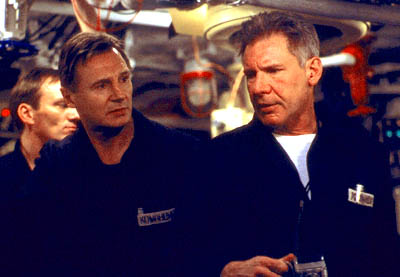

The latest submarine movie to surface on screen is K-19: The Widowmaker, and this time, it's based on a true story. In the middle of the Cold War, a Russian submarine was close to meltdown, which would undoubtedly sparked World War III. The story only came out after the fall of Communism, and it was just a matter of time before it arrived in theaters. The core story reads like a screenplay, with many highly dramatic points, but the movie plays out like most other submarine movies. Obviously, something happened to save the ship, so it is left to director Kathryn Bigelow (The Weight of Water, Strange Days) to fill in the gaps. The result is a well-made action movie that is a high on style and low on substance. As with many movies that take place internationally, here, everybody speaks English with a Russian accent. Stars Harrison Ford and Liam Neeson do an amusing job trying to manage, but the former just never pulls it off.
Ford (What Lies Beneath, Random Hearts) is Captain Alexi Vostrikov, brought on to the K-19 after the previous Captain, Mikhail Polenin (Neeson, The Endurance, Gun Shy) upset the Communist Party. The crew trusts Polenin, who treats his men like a family. Alternatively, Vostrikov rules with an iron fist, demanding perfection and an endless series of drills. Polenin's replacement is just another omen of bad luck for the sub, nicknamed The Widowmaker because of the deaths of its men (before it left port). K-19 is the star of the Russian fleet, and the Russians want to rush the sub into service, yet the crew and Polenin believe that it is not ready. Vostrikov believes otherwise, and the sub sets sail. There are two main elements in the script by Louis Nowra (Black and White, The MatchMaker) and Christopher Kyle (The Weight of Water); the tension between the two men and the possible nuclear meltdown. The former does not play well, causing a significant portion of the first half to drag.
Bigelow does a good job of raising the tension during the possible meltdown, and especially of conveying a sense of tightness and claustrophobia within the submarine. The camera moves fluidly up and down corridors and men stumble past each other trying to get where they need to go. Things fall all over the place when K-19 undergoes a deep dive. She also easily conveys the sense of dread felt by the crew. As the core overheats, the levels of radiation rise rapidly. Some members of the crew attempt to jerry-rig a way to cool down the core, but this subjects them to intense levels of radiation poisoning. Everybody is slowly dying, and the long-range transmitter malfunctioned, so K-19 has no contact with Russia. On the flip side, this means Russia has no contact with K-19. What Bigelow fails to convey is a sense of the potential nuclear war if the core overheats. The political ramifications are enormous, yet she favors a more personal view. By humanizing the problem, it makes the danger feel more immediate.
This would work if she took the time to identify some of the crew. For the most part, the crew is an anonymous bunch of guys with Eastern accents. Of the superior officers, there is the guy with the big moustache, and the political guy that looks weasly. The doctor is bald. The only crew member with a name anyone watching can remember is Vadim Radtchenko (Peter Sarsgaard, The Salton Sea, The Center of the World), a replacement with hours of simulator experience, but no actual experience on the sub. Radtchenko's knowledge is critical, since he is the only person who knows how to handle the reactor, but his lack of actual experience becomes a huge hindrance. Still, Bigelow does an adequate job of keeping the audience on the edge of their seats. K-19 suffices as an action movie, but lacks the meat necessary to make it something better.